Image
Gallery
St. Perpetua (Nicholas Papas, Iconographer,
St. Philip's
Antiochian Orthodox Church in Souderton, PA)
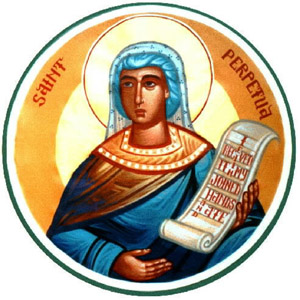 |
"Liturgical artist Nicholas Papas is a communicant at
St. Michael's Antiochian Orthodox Church in Greensburg, PA.
While studying painting at Indiana University of Pennsylvania,
Nicholas simultaneously began to learn iconography from his
priest, the Reverend John Osacky (now known as Job, Bishop of
the Midwest, O.C.A.). After receiving his degree in 1981, he
advanced his iconographic skills in Athens, Greece under the
tutelage of Nicholas and Basil Lepoura. Over the past twenty
years, Nick has continued to refine and improve his skills while
working full-time as an iconographer from his own studio."
(Click here
for more on artist Nicholas Papas) |
[Back to Image Gallery List]
St. Felicitas (Nicholas Papas, Iconographer,
St. Philip's
Antiochian Orthodox Church in Souderton, PA)
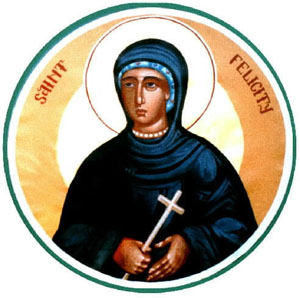 |
"Liturgical artist Nicholas Papas is a communicant at
St. Michael's Antiochian Orthodox Church in Greensburg, PA.
While studying painting at Indiana University of Pennsylvania,
Nicholas simultaneously began to learn iconography from his
priest, the Reverend John Osacky (now known as Job, Bishop of
the Midwest, O.C.A.). After receiving his degree in 1981, he
advanced his iconographic skills in Athens, Greece under the
tutelage of Nicholas and Basil Lepoura. Over the past twenty
years, Nick has continued to refine and improve his skills while
working full-time as an iconographer from his own studio."
(Click here
for more on artist Nicholas Papas) |
[Back to Image Gallery List]
Late
Antique Perpetua from the Sixth-Century Wall Mosaics at the Eufrasiana
Basilica in Porec
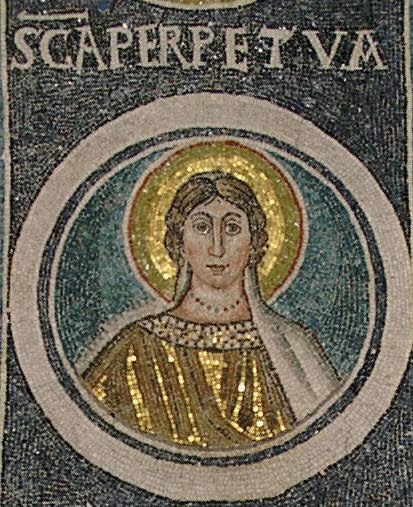
[Back to Image Gallery List]
Late
Antique Perpetua from the Sixth-Century Wall Mosaics at the Eufrasiana
Basilica in Porec
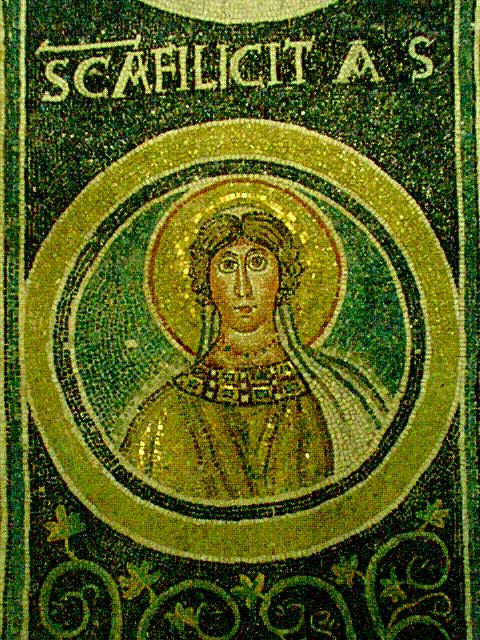
[Back to Image Gallery List]
St.
Perpetua (Archiepiscopal
Chapel; Ravenna.The
two mosaic cycles in the Archiepiscopal Chapel created for Pietro
II [494-95])
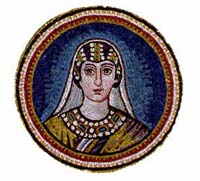
[Back to Image Gallery List]
St.
Felicitas (Archiepiscopal
Chapel; Ravenna.
The two mosaic cycles in the Archiepiscopal Chapel created for Pietro
II [494-95])
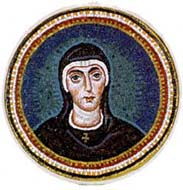
[Back to Image Gallery List]
North
African Perpetua & Felicitas (Robert
Lentz)
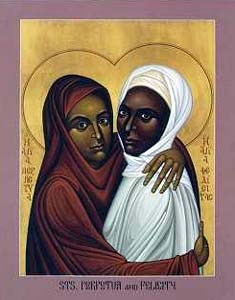
|
"Robert Lentz is a master iconographer of the school
of Photios
Kontoglou. Robert was born in rural Colorado in 1946.
His father's family had emigrated from southwestern Russia
at the turn of the century. Robert grew up with his grandmother's
stories of Cossack soldiers and lives of the saints. ...His
journeys have brought him close to the struggles of modern
men and women for a more just world. Realizing that the only
hope for preserving his Russian roots lay in adapting their
essence to the modern world, he began painting Russian icons
of modern "saints." His icons enable people of many
different cultures and religious backgrounds to share in the
rich traditions of the Byzantine East" (Click here for
a picture and full Trinity
Stores Bio)
|
[Back to Image Gallery List]
St.
Perpetua & Felicitas (Saints of Color, Office of Black Catholic
Affairs; Date & Creator Unknown)
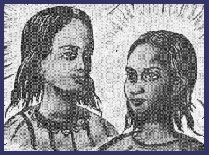
[Back to Image Gallery List]
GLOSSARY
Late Antiquity (200-700 AD) is characterized by
the acceptance of Christianity as state religion, increasing border
troubles in west and east, and the grand solution of dividing the
empire into two halves (Nicholson's Timeline; Liebeschuetz 4).
[Return
to Top]
BIBLIOGRAPHY & RESOURCES
Blanchard-Lemee, Michele, et. al. Mosaics of Roman Africa. NY:
George Braziller, 1996.
Borriello, Mariarosaria, et. al. Pompei. Italy, Ferrara Arte S.A.,
1996.Brilliant, Richard. Pompeii AD 79. NY: Clarkson N. Potter,
Inc., 1979.
Etienne, Robert. Pompeii: The Day a City Died. NY; Harry Abrahms.Kraus,
Theodor. Pompeii and Herculaneum.NY: Harry Abrahms, 1975.
Raven, Susan. Rome in Africa, 3rd ed. NY: Routledge, 1993.
Renaud, Chris. The
Other: Race, Ethnicity, and Gender in the Ancient World: Bibliography.
18 February 200. <http://www2.carthage.edu/outis/obib.html>.
8 January 2004.
Snowden, Frank M. Before Color Prejudice. Cambridge, MA: Harvard
UP, 1983.
Terry, Ann and Tom Muhlstein, "New
Documentary Evidence for the Restoration of the Sixth-Century Wall
Mosaics at the Eufrasiana in Porec" (Abstract)
Eufrasiana Basilica. July 10 1999 <http://nickerson.icomos.org/euf/euf-idx.htm>
8 January 2004.
Veyne, Paul, ed. A History of Private Life: from Pagan Rome to
Byzantium. Cambridge, MA: Harvard UP, 1987.
Witt, R.E. Isis in the Greco-Roman World. Ithaca, BY: Cornell UP,
1971.
Woloch, G. Michael. Roman Cities. Madison: U of Wisconsin P, 1983.
[Return
to Top] |